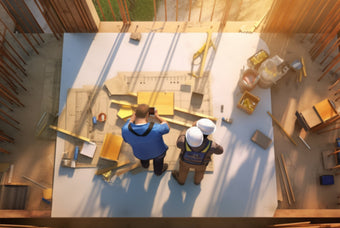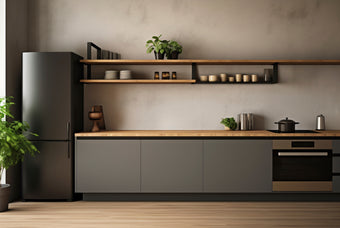Most popular
Building a greener future is no longer a choice but a necessity. Startups around the world are increasingly recognizing the importance of sustainability and are looking for ways to incorporate eco-friendly practices into their operations. One area where startups can make a significant impact is in their choice of building materials. By opting for sustainable building materials, startups can not only reduce their environmental footprint but also contribute to a healthier and more sustainable future. In this article, we will explore the different types of sustainable building materials that are ideal for startups. From recycled materials such as reclaimed wood and metal to innovative alternatives like bamboo and hempcrete, there are numerous options available that are both environmentally friendly and cost-effective. By embracing sustainable building materials, startups can enhance their brand image, attract environmentally conscious customers, and contribute to a greener future. Join us as we delve into the world of sustainable building materials and discover how startups can integrate them into their projects to create a better tomorrow.
Benefits of using sustainable building materials
Using sustainable building materials offers numerous benefits that extend beyond environmental considerations. Firstly, such materials promote resource efficiency by utilizing renewable resources, recycled materials, or those with minimal environmental impact, thereby reducing the overall ecological footprint of construction projects. Additionally, they contribute to improved indoor air quality by minimizing off-gassing of volatile organic compounds (VOCs) and other toxins, which enhances occupant health and comfort. Economically, sustainable materials often exhibit long-term cost savings through reduced energy consumption and maintenance requirements. Moreover, they support local economies by promoting the use of locally sourced materials and fostering green jobs in manufacturing and installation. Ultimately, embracing sustainable building materials not only addresses environmental concerns but also enhances building performance, occupant well-being, and community resilience.

Common types of sustainable building materials
-
Recycled Materials: Materials like recycled steel, reclaimed wood, and recycled glass reduce the demand for virgin resources and divert waste from landfills.
-
Renewable Materials: These include materials derived from rapidly renewable resources such as bamboo, cork, and straw, which regenerate quickly and have minimal environmental impact.
-
Low-impact Materials: These materials, such as rammed earth, adobe, and hempcrete, are often locally sourced and have a low environmental footprint both in terms of production and disposal.
-
Energy-efficient Materials: Materials designed to improve energy efficiency, such as high-performance insulation (e.g., cellulose, wool), low-emissivity windows, and cool roofs, contribute to reduced energy consumption and lower greenhouse gas emissions.
-
Non-toxic Materials: Materials that do not emit harmful chemicals or VOCs, such as natural paints and finishes, contribute to better indoor air quality and occupant health.
-
Durability and Longevity: Materials that are durable and require minimal maintenance, such as stone, brick, and metal roofing, reduce lifecycle costs and environmental impact over time.
By incorporating these types of sustainable building materials, construction projects can achieve reduced environmental impact, improved occupant health and comfort, and long-term economic benefits.
Factors to consider when choosing sustainable building materials for startups
When startups are choosing sustainable building materials, several factors should be carefully considered to align with their goals and values:- Cost-effectiveness: Evaluate the initial costs versus long-term savings and benefits of sustainable materials. Consider lifecycle costs, including maintenance and operational expenses.
- Environmental Impact: Assess the environmental footprint of materials, including their resource extraction, manufacturing process, transportation emissions, and potential for recycling or reuse.
- Availability and Sourcing: Prioritize materials that are locally sourced to reduce transportation emissions and support local economies. Consider the availability of materials and their supply chain sustainability.
- Performance and Durability: Ensure that sustainable materials meet performance requirements for the intended use, such as structural integrity, insulation properties, and durability over time.
- Certifications and Standards: Look for certifications such as LEED (Leadership in Energy and Environmental Design) or Cradle to Cradle (C2C) that validate the sustainability and environmental performance of materials.
- Health and Indoor Air Quality: Choose materials that promote good indoor air quality by minimizing VOC emissions and potential health risks to building occupants.
- Aesthetic and Design Considerations: Balance sustainability goals with aesthetic preferences and design requirements to ensure the chosen materials align with the overall vision for the startup's space.
- Regulatory Compliance: Ensure that selected materials comply with local building codes, regulations, and standards related to sustainability and environmental impact.
By considering these factors holistically, startups can make informed decisions that not only contribute to sustainability goals but also support their operational and financial objectives in the long run.
Challenges and solutions in implementing sustainable building materials
Implementing sustainable building materials faces several challenges, including higher upfront costs, limited availability of certain materials, and potential resistance to change from traditional practices. Addressing these challenges requires innovative solutions such as financial incentives and subsidies to offset initial expenses, promoting research and development for new sustainable materials, and educating stakeholders about the long-term benefits of sustainable choices. Collaboration across the construction industry, from designers and architects to builders and suppliers, is essential to overcoming these challenges and driving widespread adoption of sustainable building practices. Additionally, adopting standardized certifications and integrating sustainability considerations into building codes can streamline the implementation process and ensure consistency in sustainable construction practices.
|
Material Type |
Sustainable Building Materials |
Traditional Building Materials |
|
Example Materials |
Recycled steel, bamboo flooring, rammed earth |
Concrete, virgin timber, conventional insulation |
|
Initial Cost |
May be higher due to limited availability and specialized production processes |
Often lower due to widespread availability and established supply chains |
|
Lifecycle Cost |
Often lower due to reduced maintenance, energy savings, and longevity |
Higher due to maintenance, replacement, and operational costs over time |
|
Environmental Impact |
Lower due to reduced resource extraction, energy use, and emissions |
Higher due to resource-intensive extraction, higher energy use in production |
|
Regulatory Compliance |
May require certifications but generally aligns with sustainability standards |
Usually compliant with basic building codes; may lack specific sustainability criteria |
|
Availability |
Variable; some materials may be regionally restricted or niche markets |
Widely available with established supply chains and distribution networks |
|
Long-term Benefits |
Improved indoor air quality, energy efficiency, and resilience |
Standard performance with potential for higher operational costs over time |
This framework highlights that while sustainable building materials may have higher initial costs, they often offer long-term savings through reduced maintenance and operational expenses, alongside environmental benefits. It's crucial for decision-makers in construction to assess these factors comprehensively to determine the most suitable materials for their projects.
Promoting a green image with sustainable building materials
Promoting a green image through the use of sustainable building materials can be a powerful strategy for businesses and organizations looking to demonstrate their commitment to environmental responsibility. By choosing materials like recycled steel, bamboo, or reclaimed wood, companies not only reduce their carbon footprint but also showcase their dedication to sustainable practices. Incorporating energy-efficient solutions such as solar panels or green roofs further enhances this image by visibly demonstrating a commitment to renewable energy and reducing operational impacts. Communicating these choices effectively through marketing materials, certifications like LEED, and public relations efforts helps reinforce the organization's green credentials to stakeholders, customers, and the broader community. This proactive approach not only aligns with growing consumer preferences for eco-friendly businesses but also fosters a positive reputation for innovation and corporate social responsibility.
Conclusion: The future of sustainable building materials for startups
In conclusion, sustainable building materials represent a promising future for startups looking to align environmental responsibility with business goals. As awareness of climate change and resource depletion grows, so does the demand for eco-friendly solutions in construction. Startups adopting sustainable materials not only contribute to global sustainability efforts but also position themselves as leaders in innovation and responsible business practices. While challenges like initial costs and material availability persist, ongoing advancements in technology and increasing market demand are driving down costs and expanding options. Moving forward, startups that prioritize sustainability in their building materials can anticipate long-term benefits such as reduced operational costs, enhanced brand reputation, and a competitive edge in a market increasingly focused on environmental stewardship. By embracing these opportunities, startups can not only build environmentally friendly spaces but also pave the way for a more sustainable future in construction and beyond.
Empty content. Please select category to preview
Join our newsletter now
Promotions, new products and sales. Directly to your inbox.





